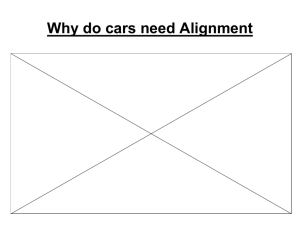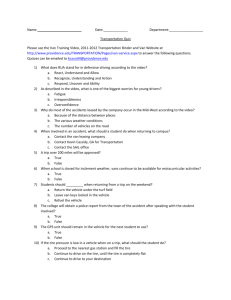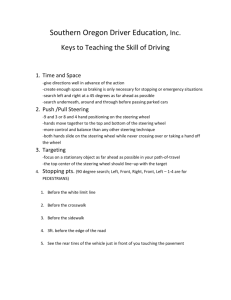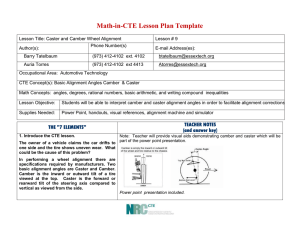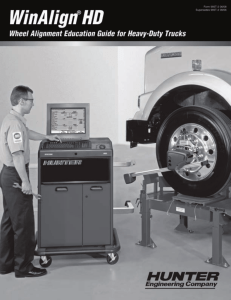Transportation Training
advertisement
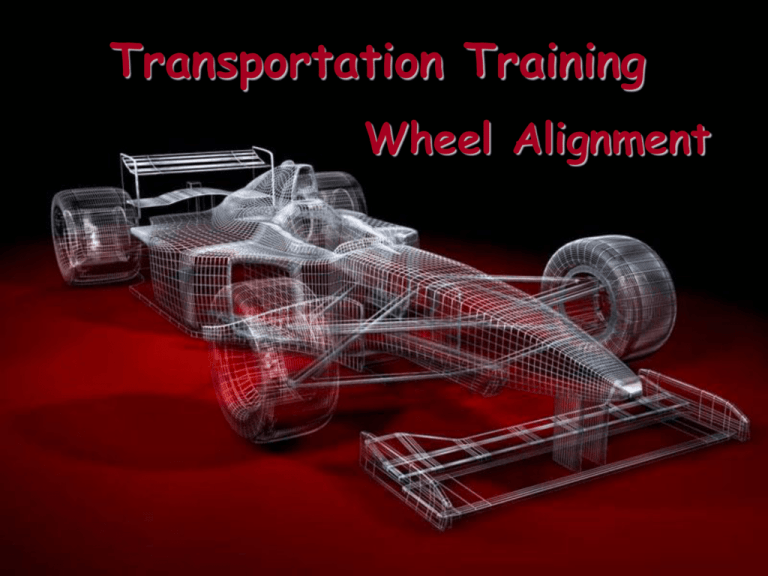
Transportation Training Wheel Alignment Why Align the Wheels? Correct Wheel alignment is essential to vehicle safety. Improve Handling Ability Maximum Fuel Economy Prolong Tire Life By Allowing the tires to roll freely without scuffing or slipping sideways under any operating conditions Alignment Angles and Adjustments 1. Caster 2. Camber 3. Toe-in/out Non adjustable 4.Ride height 7.Scrub Radius 5.Thrust Angle or Tracking 8.Steering Axis Inclination 6.Steering Center 9.Toe-Out on Turns Caster Positive for power steering Negative for manual steering Caster is the forward or rearward tilt of the Steering Knuckle Caster is adjustable To increase Directional Control of the vehicle When viewed from To compensate for Road Crown the side of the Pull. vehicle.Measured To help the wheels to return to in degrees. the straight-ahead position. Camber Common camber settings are ¼ to ½ degree positive Camber is the inward or outward tilt of the top of the wheel and tire assembly Camber is adjustable To prevent tire wear on the outer or inner tread When viewed from the front of the vehicle. Measured in degrees. To load the larger inner wheel bearing vs. the smaller outer bearing.(Positive) To aid steering by placing the weight on the inner end of the spindle and reducing scrub radius. Toe-in /Toe-out Common Settings: Front Wheel Drive 1/16” or 1.5 mm Rear W Drive 1/16” to ¼” or 1.6 to 6 mm Toe-in Is the inward or outward direction of both left and right wheel and tire assemblies is when the front tires are closer at the front than at the rear When viewed from above the vehicle. Measured in inches or millimeters or degrees. Ride Height Measured in inches or centimeters at 4 locations close to each wheel Ride height is measured from the rocker panel to the ground surface Thrust Angle or Tracking Thrust angle is the direction that the rear wheels are pointing in relation to the center line of the vehicle. Thrust angle should be zero and is only adjustable on certain vehicles. Steering Wheel Center Steering center is simply the fact that the steering wheel is centered “level” when the vehicle is traveling down a straight and level road. Adjusted by toe settings and affected by thrust angle. Common Adjustments The most common adjustments are Caster, Camber, Toe, and Thrust angle Pre Alignment Inspection Worn Tires Tire Pressure Tire Size and Type Wheel or Tire runout Cradle Alignment Loose Wheel Bearings Ride Height and Weight Worn Steering and Suspension Components Tech Tip: Always Road test the vehicle before doing a wheel alignment. This helps to detect problems, like pulling or worn components. Reading Tire Wear Abnormal Tire Wear is Caused by Incorrect Tire Pressure Excessive Camber Incorrect Toe Settings Lack of Rotation Unbalanced Tire Under Rated Tires Driving Conditions Making Adjustments Caster is adjusted by moving the control arm so that the ball joint moves toward the front or rear of the vehicle and is not always adjustable. Making Adjustments Camber is changed by moving the control arm in or out without moving the ball joint forward or rearward.. Making Adjustments Toe angle is adjusted by lengthening or shortening the tie-rods.. . Suspension Types Mac Pherson Strut Suspension with Rack and Pinion Steering Conventional Suspension & Parallelogram Steering ASE-Type Questions Automotive Service Excellence Chapter 74 Transportation Training Wheel Alignment The End
